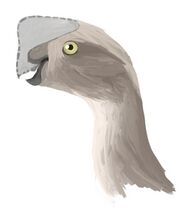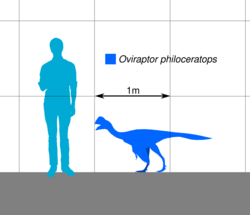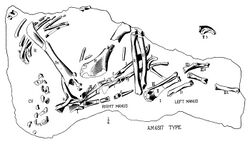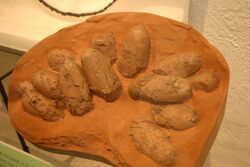Biology:Oviraptor
| Oviraptor | |
|---|---|

| |
| Skeletal diagram showing known elements of the holotype specimen (AMNH 6517) | |
| Scientific classification | |
| Domain: | Eukaryota |
| Kingdom: | Animalia |
| Phylum: | Chordata |
| Clade: | Dinosauria |
| Clade: | Saurischia |
| Clade: | Theropoda |
| Family: | †Oviraptoridae |
| Subfamily: | †Oviraptorinae |
| Genus: | †Oviraptor Osborn, 1924 |
| Type species | |
| †Oviraptor philoceratops Osborn, 1924
| |
Oviraptor is a genus of small Mongolian theropod dinosaurs, first discovered by technician George Olsen in an expedition led by Roy Chapman Andrews, and first described by Henry Fairfield Osborn, in 1924. Its name is Latin for 'egg taker' or "egg seizer", referring to the fact that the first fossil specimen was discovered atop a pile of what was thought to be Protoceratops eggs, and the specific name philoceratops means "lover of ceratopsians", also given as a result of this find. In his 1924 paper, Osborn explained that the name was given due to the close proximity of the skull of Oviraptor to the nest (it was separated from the eggs by only 4 inches or 10 centimetres of sand). However, Osborn also suggested that the name Oviraptor "may entirely mislead us as to its feeding habits and belie its character".[1] In the 1990s, the discovery of nesting oviraptorids like Citipati proved that Osborn was correct in his caution regarding the name. These finds showed that the eggs in question probably belonged to Oviraptor itself and that the specimen was actually brooding its eggs when it died at the nest.
Oviraptor lived in the late Cretaceous period, during the late Campanian stage about 75 million years ago; only one definitive specimen is known (with associated eggs), from the Djadokhta Formation of Mongolia, though a possible second specimen (also with eggs) comes from the northeast region of Inner Mongolia, China , in an area called Bayan Mandahu.[2]
Description

Oviraptor philoceratops is known from a single partial skeleton (specimen number AMNH 6517), as well as a nest of about fifteen eggs that have been referred to this species (AMNH 6508).

When living, Oviraptor was one of the most bird-like of the non-Avian theropod dinosaurs. Its rib cage, in particular, displayed several features that are typical of birds, including a set of processes on each rib that would have kept the rib cage rigid. A relative of Oviraptor called Nomingia was found with a pygostyle, which is a set of fused vertebrae that would later help support the tail feathers of birds. Skin impressions from more primitive oviraptorosaurs, like Caudipteryx and Protarchaeopteryx, clearly show an extensive covering of feathers on the body, feathered wings, and feathered tail fans. A tail fan is also indicated by the presence of a pygostyle in Nomingia, suggesting that this feature was widespread among oviraptorosaurs. Additionally, the nesting position of the brooding Citipati specimens implies the use of feathered wings to cover the eggs.[3] Given the close anatomical similarity between these species and Oviraptor, it is highly likely that Oviraptor had feathers as well.
Oviraptor is traditionally depicted with a distinctive crest, similar to that of the cassowary. However, a re-examination of several oviraptorids show that this well-known, tall-crested species may actually belong to the genus Citipati, a relative of Oviraptor.[4] It is likely that Oviraptor did have a crest, but its exact size and shape are unknown due to crushing in the skull of the only recognized specimen.
The Oviraptor has two long, well developed hind limbs, each had three clawed fingers that were used to hold, rip and tear their prey. The Oviraptor had large eyes with bony rings and an unusual cranial crests along with a toothless beak.[5]
Classification


Oviraptor was originally allied with the ornithomimids by Osborn due to its toothless beak. Osborn also found similarities with Chirostenotes, which is still considered a close relative of Oviraptor.[1] In 1976, Barsbold erected a new family to contain Oviraptor and its close kin, making Oviraptor the type genus of the Oviraptoridae.[6]
While the original specimen of Oviraptor was poorly preserved, especially the crushed and deformed skull, new and more complete oviraptorid specimens were assigned to the genus in the 1970s and 1980s. In 1976, Barsbold referred six additional specimens to the genus Oviraptor (including IGM 100/20 and 100/21),[6] but these were later reclassified in the new genus Conchoraptor.[7] Another specimen, IGN 100/42, is perhaps the most famous, owing to its well-preserved complete skull and large size. This specimen was referred to the genus Oviraptor by Barsbold in 1981[8] and came to represent Oviraptor in most popular depictions and in scientific studies of oviraptorids.[9] However, this specimen, with its distinctive tall, cassowary-like crest, was re-examined by the scientists who described the nesting oviraptorids, and found to resemble them more closely than the original specimens of Oviraptor. For this reason, they removed IGN 100/42 from the genus Oviraptor, provisionally re-classifying it as a species of Citipati.[4]
The cladogram below follows an analysis by Fanti et al., 2012.[10]
| Oviraptoridae |
| |||||||||||||||||||||||||||||||||||||||||||||
Paleobiology

As its name suggests, Oviraptor was originally presumed to have eaten eggs, based on its association with a fossilized nest (specimen number AMNH FR 6508) thought to belong to Protoceratops.[1] The idea of a crushing jaw was first proposed by H. F. Osborn, who believed that the toothless beak of the original skull, together with an extension of several bones below the jaw from the palate, would have made an "egg-piercing" tool. In 1977, Barsbold argued that the strength of its beak would indicate that it was strong enough to break the shells of mollusks such as clams, which are found in the same geological formation as Oviraptor. These bones form part of the main upper jaw bone or maxilla, which converge in the middle to form a pair of prongs. The rest of the bony palate, unlike all other dinosaurs, is extended below the jaw line and would have pushed into the space between the toothless lower jaws. A beak (rhamphotheca) covered the edges of the upper and lower jaws and probably the palate, as proposed by Barsbold and Osborn.
The discovery of nesting specimens of the related Citipati, with the same types of egg in the original Oviraptor specimen, showed that the eggs actually belonged to Oviraptor, not Protoceratops, and that the type specimen was likely brooding the eggs, not feeding on them. While this discovery did not rule out the possibility that Oviraptor included eggs in its diet, its exact feeding strategies remain unknown. The only Oviraptor philoceratops skeleton preserved the remains of a lizard in the region of its stomach cavity,[11] implying that the species was at least partially carnivorous.[12]
See also
References
- ↑ 1.0 1.1 1.2 Osborn, H.F. (1924). "Three new Theropoda, Protoceratops zone, central Mongolia." American Museum Novitates, 144: 12 pages, 8 figs.; (American Museum of Natural History) New York. (11.7.1924).
- ↑ Dong and Currie, P. (1996). "On the discovery of an oviraptorid skeleton on a nest of eggs at Bayan Mandahu, Inner Mongolia, People's Republic of China." Canadian Journal of Earth Sciences, 33: 631-636.
- ↑ Paul, G.S. (2002). Dinosaurs of the Air: The Evolution and Loss of Flight in Dinosaurs and Birds. Baltimore: Johns Hopkins University Press.
- ↑ 4.0 4.1 Clark, J.M., Norell, M.A. & Barsbold, R. (2001). "Two new oviraptorids (Theropoda: Oviraptorosauria), Upper Cretaceous Djadokhta Formation, Ukhaa Tolgod, Mongolia." Journal of Vertebrate Paleontology 21(2): 209-213. June 2001.
- ↑ "Oviraptor | dinosaur genus" (in en). Encyclopedia Britannica. https://www.britannica.com/animal/Oviraptor.
- ↑ 6.0 6.1 Barsbold, Rinchen (1976). "(title in Russian)". Doklady Akademii Nauk SSSR 226 (3): 685–688.
- ↑ Barsbold, R. (1986). "Raubdinosaurier Oviraptoren" [in Russian]. In: O.I. Vorob’eva (ed.), Gerpetologičeskie issledovaniâ v Mongol’skoj Narod−not Respublike, pp. 210–223. Institut èvolûcionnoj morphologic I èkologii životnyh him. A.N. Severcova, Akademiâ Nauk SSSR, Moscow.
- ↑ Barsbold, R. (1981). "Toothless dinosaurs of Mongolia." Joint Soviet-Mongolian Paleontological Expedition Transactions, 15: 28-39. [in Russian].
- ↑ Barsbold, R., Maryanska, T., and Osmolska, H. (1990). "Oviraptorosauria," in Weishampel, D.B., Dodson, P., and Osmolska, H. (eds.). The Dinosauria. Berkeley: University of California Press, pp. 249-258.
- ↑ Fanti F, Currie PJ, Badamgarav D (2012). "New Specimens of Nemegtomaia from the Baruungoyot and Nemegt Formations (Late Cretaceous) of Mongolia." PLoS ONE, 7(2): e31330. doi:10.1371/journal.pone.0031330
- ↑ (1995) "Discovering Dinosaurs" U. of California Press
- ↑ Norell, Clark, Chiappe, and Dashzeveg, (1995). "A nesting dinosaur." Nature, 378: 774-776.
Wikidata ☰ Q131070 entry
 |

